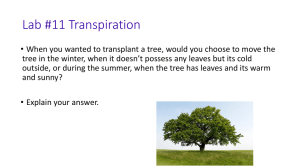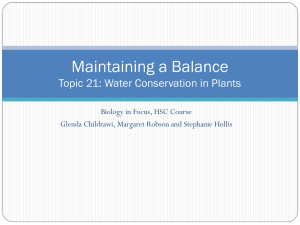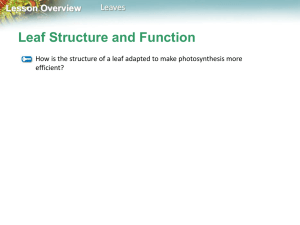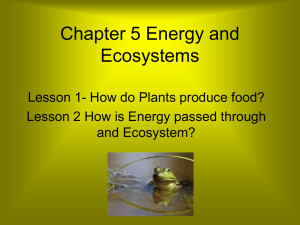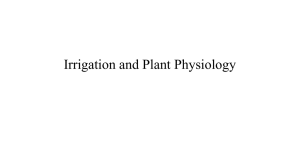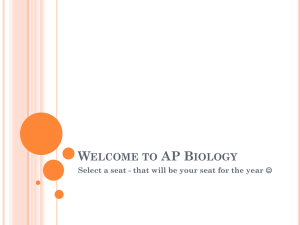Grace Cussano
advertisement
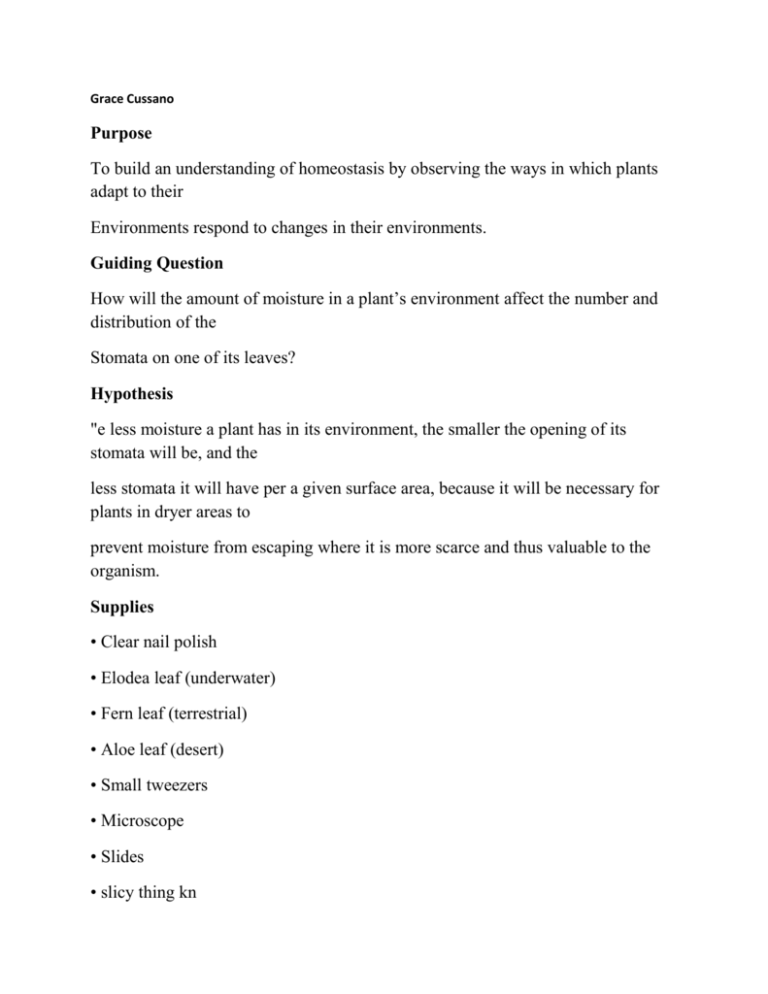
Grace Cussano Purpose To build an understanding of homeostasis by observing the ways in which plants adapt to their Environments respond to changes in their environments. Guiding Question How will the amount of moisture in a plant’s environment affect the number and distribution of the Stomata on one of its leaves? Hypothesis "e less moisture a plant has in its environment, the smaller the opening of its stomata will be, and the less stomata it will have per a given surface area, because it will be necessary for plants in dryer areas to prevent moisture from escaping where it is more scarce and thus valuable to the organism. Supplies • Clear nail polish • Elodea leaf (underwater) • Fern leaf (terrestrial) • Aloe leaf (desert) • Small tweezers • Microscope • Slides • slicy thing kn • Camera Proceduree 1. put nail polish on the bottom of the elodea, then let it dry. 2. Using the thin knife and tweezers, peel the nail polish off of the leaf. 3. Place the sliver of nail polish onto a slide, and focus it under the microscope. 4. Use the camera to document observations on each zoom level of the microscope. 5. Repeat steps 1-4 with the aloe leaf and the fern leaf. Data Our data was collected in a somewhat unorganized manner, mainly because of a very speci#c issue with what we were doing: in search of stomata, the respiratory cells of the leaves, we were taking cells from the top of the leaves where they are not present, rather than the underside where they actually exist (this change is now re$ected in our procedure). We also had some issues with the nail polish distorting the cells and a%racting numerous artifacts into the slides, as well as issues simply with the availability of clear nail polish throughout the several days during which we conducted our experiment. Nonetheless, a&er having examined countless samples under the microscope to li%le avail, we were able to collect three particularly signi#cant images which were very relevant in testing our hypothesis. Displayed on the following page, they are, in order from le& to right, the underside of an elodea leaf, the underside of a leaf belonging to a different terrestrial plant than the fern, but still one from a similar environment, and the George Woodliff-Stanley, David Hein, Morgan Benninger, and Sarah Knill October 7 - October 24, 2010 Mr. Miller - Biology Investigation #4 - Homeostasis Experiment Dra" #1 underside of an aloe leaf. All three pictures were taken with the microscope at a zoom level of 10x magni#cation. "e differences in color between the desert sample and the other two samples are directly related to the fact that the desert sample was taken using the nail polish technique while the other two leaves were simply placed directly under the microscope, so they can be ignored. Here are the images: UNDERWATER DESERT Analysis and Discussion TERRESTRIAL Our hypothesis, on its own, was clearly supported by our data. We counted approximately 60 stomata in the picture of the terrestrial sample, which was taken at the same zoom level as the desert plant, on which we counted only 20. "e stomata on the terrestrial plant appeared to be slightly larger than those on the desert plant as well, further supporting our hypothesis. "e only area in which our hypothesis was incorrect was that of the underwater plant, which, despite having by far the most wet environment, had no stomata at all. Further research showed that this was because stomata are respiratory pores whose only functions are taking carbon dioxide from and releasing oxygen and moisture back into the air, and thus they cannot be found on leaves of plants which are submerged completely underwater, where there is no air from which carbon dioxide can be taken. Nonetheless, with regards only to the plants whose environments are not underwater, our hypothesis was supported, as the plant with the more moist environment had approximately three times as many stomata as the plant in the drier environment. Furthermore, the original fern leaf we tested (not pictured above due to the lack of a photograph in which the stomata are clearly visible) whose environment was also much more moist than that of the desert plant was host to what seemed like many more stomata than were on the desert sample. If the hypothesis were the only thing we cared about in this experiment, it would have been a complete success. "ere was a fundamental $aw, however, with our experiment as a whole. "e purpose of our experiment, which has now been modi#ed to show what it used to be and what it should have been using struck-through text, was centered around the idea of how plants adapt to their environments, which is a key concept in the theory of evolution. It did not, however, address the ways in which plants actively respond to changes in their environments, which is what it would have needed to address to truly answer the question of what homeostasis is and how it works. Our experiment was an excellent example of evolution, in that the plants with the least amount of moisture in their environments George Woodliff-Stanley, David Hein, Morgan Benninger, and Sarah Knill October 7 - October 24, 2010 Mr. Miller - Biology Investigation #4 - Homeostasis Experiment Dra" #1 presumably underwent a process of natural selection in which those with the fewest and smallest stomata were able to retain the most moisture and thus survive for the longest, leading to higher reproduction rates and dominance over time. Similarly, those in the moister environments did not need to worry so much about retaining water due to its abundance in their environments, and so those with a greater number of stomata which were able to process more carbon dioxide and oxygen were more successful, and thus became dominant over time in we%er areas. Clearly, our experiment was more #t for our #nal investigation in which we will be delving into the theory of evolution than it was for this fourth investigation, in which the intent was to learn about homeostasis. Nevertheless, we did inadvertently witness an example of homeostasis during the course of our experiment. As we were observing one of the terrestrial leaves which we had pulled from its plant and placed directly under the microscope moments before, we noticed that the openings in the center of its stomata were slowly shrinking. "is was only something we observed only on the leaves which were placed under the microscope in their entirety, and not those from which we separated the surface cells with clear nail polish. Further research revealed that this was, indeed, a mechanism used by plants to regulate the amount of moisture exiting through the stomata. Once the leaf had been removed from the plant, the stomata closed in a #nal a%empt to preserve the moisture inside the leaf and keep it alive. In the end, this experiment was a positive learning experience, as it opened our eyes to the small but important difference between phenomena that are the result of evolution and those which are truly examples of homeostasis. It also gave us an opportunity to extend our knowledge from investigation two, in which we simply examined the structure and functionality of cells. We now understand that the number and distribution of stomata on the leaf of a plant differ between environments with varying amounts of moisture as a result of evolution, while the active changes in the size of the stomata’s openings in response to changes in the amount of moisture in the plants’ environments are examples of homeostasis. Furthermore, the additional research we did a&er completing our experiments solidi#ed our understanding of homeostasis as any mechanism in an organism which responds to changes in its environment to maintain equilibrium, or balance, between its internal conditions and the external conditions. For example, when a human is in a hot environment, they need to do something to cool themselves down, so that they can balance the heat around them with the coolness inside of them, thus maintaining equilibrium. "e body naturally takes care of this by sweating – the moisture cools the body down as it evaporates – a perfect example of homeostasis. In our experiment, when we observed the stomata openings shrinking, we were watching homeostasis in action, because the cells were reacting to having been disconnected from their moist environment, a%empting to achieve equilibrium with their new dry environment by retaining as much moisture as possible inside the leaf.
